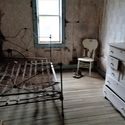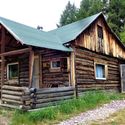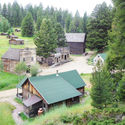South of the Border: "Side trip to a ghost town: Garnet, Montana"
September 11, 2019
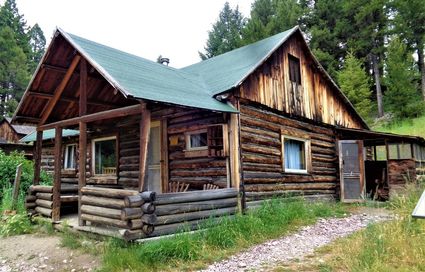
Ole and Marion Dahl built this cabin and a nearby saloon during a brief resurgence in mining in Garnet during the 1930's. Over time the Dahl's added a porch and kitchen to the cabin and a generator system to provide electricity to their saloon across the street. Marion lived in the cabin until 1960. The present Garnet Visitors' Center is located in the old saloon building.
Columnist's note: About 30 miles east of Missoula on MT Highway 200, while taking a couple of my grandsons back to the Seattle area, I saw the sign for the turnoff to 'Garnet Ghost Town.' I'd passed the turnoff many times. I told the kids, "Today we're going to the ghost town." 'Ghost town' got a positive response from the ten and twelve year old boys.
Established in 1895 Garnet became a ghost town in the late 1940's when it lost most of its population and businesses. Renovation and preservation efforts are now under management of the Bureau of Land Management with support from the Garnet Preservation Association. A few private houses/cabins are in the area but it is an historic district open to the public.
Garnet is neither commercialized nor heavily visited as a tourist destination. Its location at 6000 feet at the end of an 11-mile gravel road with tight curves and washboard bumps helps preserve the charm of the town. The town took its name from the Garnet Range where the ghost town is located. Here's some of what I learned about Garnet on a recent visit.
Garnet boomed in 1897 after a discovery
of a major vein of gold
Gold was first found at the First Chance Gulch in 1865. Miners leaving played out mines in Colorado and California had explored the area for several years. In 1896 the Nancy Hanks Mine produced $690,000 in gold ($21 million in today's value). Mining companies and miners poured into the area.
The mining camp was not built for the long term, most buildings not even on foundations. By 1898 nearly 1,000 people resided in Garnet. At its highpoint the mountain community boasted four mercantile stores, four hotels, three livery stables, two barber shops, a union hall, a butcher shop, a candy shop, a doctor's office, an assay office and 13 saloons. Unlike other mining camps, many miners at Garnet brought their families. The local school had 40+ students at one point.
Garnet had an active social life (other than just the saloons) and a good relationship between the mining companies and the unionized miners. Some darker activities common to mining camps existed but were minimized. The union had its own hall and hosted weekly dances on a dance floor made of "springy maple wood."
The isolation of the camp made it difficult to bring in modern equipment and the old placer mines (using water to wash away the dirt and rock) became uneconomical. The most easily available gold ran out and the town faltered. By 1905 about 150 people lived in Garnet. In 1912 a fire raged through much of the town, destroying several major businesses that never rebuilt. World War I soon took people to other jobs and places.
A doubling in gold prices brought a brief reprise for Garnet in 1934. Some miners moved back. A few businesses had continued to operate. F.A. Davey owned the patent for the Garnet Claim, where much of the town was built. Davey ran the mercantile until he died in 1947. Though he owned much of the land the town was built on a fraternal organization buried him because of his minimal assets. The three-story J.R. Wells Hotel (which still stands) continued to operate. In 1938 Ole and Marion Dahl built a cabin. They lived in the cabin and built a saloon just down the street. The saloon is now the Visitors' Center and the Dahl cabin is one of two rentals available during the winter months. Marion Dahl still lived in the cabin until 1960.
Observers say when the miners left it was as if they just walked away and left everything in place. After Garnet was abandoned souvenir hunters took many of the remaining artifacts as well as doors, woodwork, stairways and the cloth wallpaper in the elegant old hotel.
Preservation efforts began in earnest in 1970
Today Garnet is managed by the Bureau of Land Management (BLM) with support from the not-for-profit Garnet Preservation Association. Preservation efforts have focused on the old commercial section of the town where most of the buildings date to the 1890's. The 1890's-era structures being restored include the J.R. Wells Hotel, Kelly's Saloon and F. A. Davey's mercantile. Dahl's Saloon and Dahl's Cabin (both built in the late 1930's) are also preserved. Several hiking trails access the surrounding area where the mines operated.
Through efforts of some BLM staffers the Garnet Ghost Town was added to the National Register of Historic Places in 2010. The 134 acre site includes 83 buildings, 48 structures and 55 cultural features. Visitors can walk through the old buildings being restored.
If you want to visit Garnet or be
a part of its restoration...
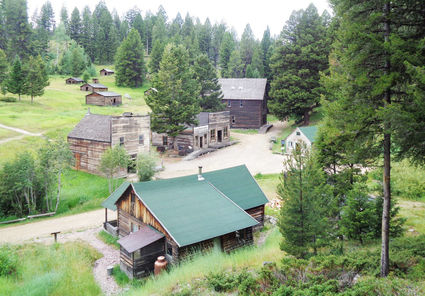
This is a view from the footpath that leads down to the commercial district of the old mining town of Garnet. Most of the buildings facing the camera were built in the late 1890's when the town flourished and survived a fire in 1912 that destroyed many of the existing businesses. For all practical purposes Garnet, about 30 miles east of Missoula on MT Highway 200, became a ghost town in the late 1940's.
Garnet Ghost Town has a helpful website at: garnetghosttown.org/. There you can find hours of operation (most all the summer and some winter), directions to reach Garnet, activities at the site as well as nearby areas and contacts for renting the two cabins available during the winter (call 406-329-3914 for cabin rentals). There is some up and down walking to get to the town site and mountain weather changes quickly-be prepared and properly dressed.
The future of Garnet depends on the work of volunteers and contributions from the public. There are a number of ways to volunteer at Garnet through various BLM programs. The non-profit Garnet Preservation Association also supports educational and preservation projects at the old town site. Learn more about ways you can help preserve this historic town by calling the Bureau of Land Management's Field Office in Missoula at 406-329-3914.



